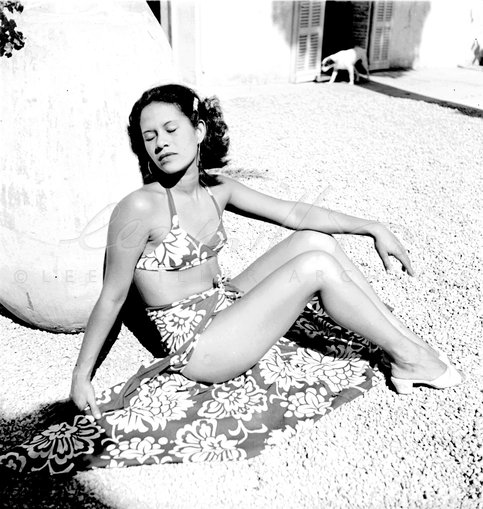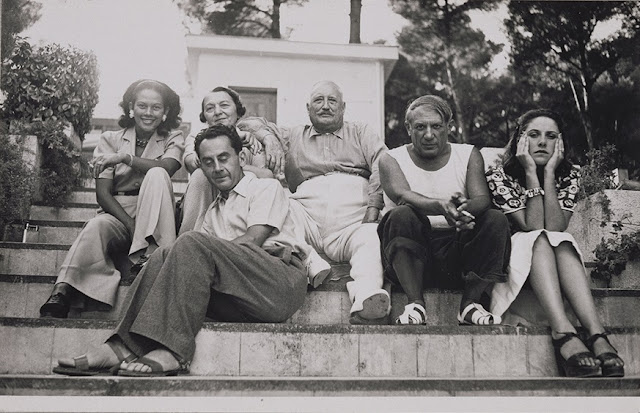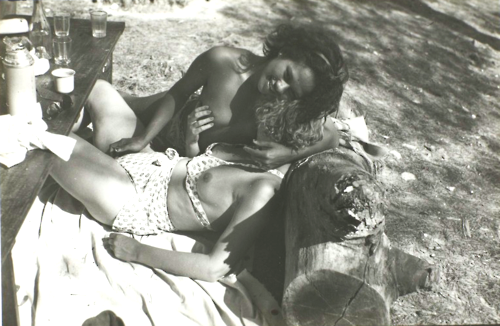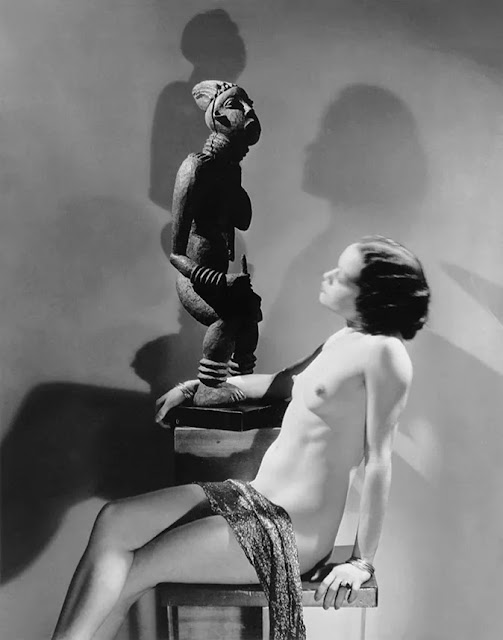Ady Fidelin was born in 1915 in Pointe-à-Pitre into one of Guadeloupe’s oldest Creole families, immigrating to France in the wake of the catastrophic 1928 cyclone that devastated the Caribbean, killing thousands. The death of her mother during this traumatic event and the passing of her father a few years later precipitated her migration to Paris to join family members who had made the passage before her. She arrived in France in one of the successive waves of émigres from the island, lured by the hope of a better life in the storm’s aftermath.
"Under the lively and cheerful pen of Gisèle Pineau, Ady Fidelin, muse and lover of Man Ray, finds her place in the sun" ELLE
Harper Bazaar’s publisher William Randolph Hearst, like many magazine proprietors, prohibited the use of black models in his publications. But somehow (possibly with the help of Bazaar’s editor Carmel Snow, who took issue with Hearst’s stance on race), a photograph of Adrienne by Man Ray featured in the September 1937 edition, making Ady Fidelin the first ever black woman to appear in a major fashion magazine. The two page spread was titled ‘The Bushongo of Africa Sends His Hats to Paris’.
More on black models
Once in America, unbeknownst to Ady, Man Ray began a relationship with Juliet Browner whom he married in 1946, even as Ady struggled to save his works from German covetousness before returning them to her after Liberation. Although they maintained a correspondence at least until 1961, Man Ray barely speaks of her in his 1963 autobiography, following in this an earlier assessment where he had made his companion "a subordinate in the service of his brilliant partner " . However, in the 1970s he published a series of prints inspired by Ady
Wendy A. Grossman and Sala E. Patterson believe that "Fidelin has been sidelined, victim of a conventional history that privileges racial or ethnic character over individuality, and the male artist over the female muse” . At the end of the 1950s, she married André Art, her companion for more than a decade. She spent the last moments of her life in Albi and died anonymously at the age of 88.
More on Ady Fidelin
Lee Miller
Ady Fidelin, c. 1937
Hotel Vaste Horizon, Mougins, France
Fidelin’s relationship with Man Ray, first registered in entries in his date book in December of 1935, subsequently led to her introduction to Picasso and the circle of creatives who would become her virtual family for the next five years.
Man Ray and Ady Fidelin, c. 1937
Mougins, France
She appears in close to 400 photographs by Man Ray, as well as several paintings, drawings, prints and a short film by the American artist. She was also photographed by Wols (Alfred Otto Wolfgang Schulze) and was the subject of a recently identified painting by Picasso. More on Ady Fidelin
Ady Fidelin, Marie Cuttoli and her husband, Man Ray, Picasso and Dora Maar, 1937
Lee Miller
Picnic (Nusch Eluard, Paul Eluard, Roland Penrose, Man Ray, Ady Fidelin)
Gelatin silver print, 1937 (2012)
8 in. x 7 3/4 in. (203 mm x 197 mm)
National Portrait Gallery
Penrose met American-born photographer and photojournalist Lee Miller (1907-77) in Paris in 1937, and this photograph depicts them on holiday with friends at Mougins in the South of France.
Lee Miller with Ady Fidelin, c. 1937
Île Sainte-Marguerite, Cannes
Elizabeth "Lee" Miller, Lady Penrose (April 23, 1907 – July 21, 1977), was an American photographer and photojournalist. She was a fashion model in New York City in the 1920s before going to Paris, where she became a fashion and fine art photographer. During the Second World War, she was a war correspondent for Vogue, covering events such as the London Blitz, the liberation of Paris, and the concentration camps at Buchenwald and Dachau.
In 1929, Miller intended to apprentice with the surrealist artist and photographer Man Ray. Although, at first, he insisted that he did not take students, Miller soon became his model and collaborator, as well as his lover and muse.
More on Lee Miller
Pablo Picasso
Woman Seated on a Yellow and Pink Background II (Portrait of Ady Fidelin) September 8, 1937
Oil on canvas
81 x 60 cm.
Estate of Pablo Picasso
Man Ray
Adrienne Fidelin, Pablo Picasso, Dora Maar, 1937
Pablo Ruiz Picasso (25 October 1881 – 8 April 1973) was a Spanish painter, sculptor, printmaker, ceramicist and theatre designer who spent most of his adult life in France. One of the most influential artists of the 20th century, he is known for co-founding the Cubist movement, the invention of constructed sculpture, the co-invention of collage, and for the wide variety of styles that he helped develop and explore. Among his most famous works are the proto-Cubist Les Demoiselles d'Avignon (1907), and the anti-war painting Guernica (1937), a dramatic portrayal of the bombing of Guernica by German and Italian air forces during the Spanish Civil War.
More on Pablo Picasso
Currently part of the collection of the private Dapper Museum in Paris, the Bangwa Queen figure can be seen in this photograph in the company of a woman believed to be Man Ray's lover, model, and muse, Adrienne Fidelin
Man Ray (American, 1890–1976)
Ady Fidelin, ca. 1937
Gelatin silver print
5.8 x 8.8 cm. (2.3 x 3.5 in.)
Private collection
Man Ray
Ady Fidelin & Nusch Eluard
Nusch Éluard (born Maria Benz; 21 June 1906 – 28 November 1946) was a French performer, model and surrealist artist.
Nusch arrived in France as a stage performer, variously described as a small-time actress, a traveling acrobat, and a "hypnotist's stooge". She met Paul Éluard in 1930 working as a model, married him in 1934, produced surrealist photomontage and other work, and is the subject of "Facile," a collection of Éluard's poetry published as a photogravure book, illustrated with Man Ray's nude photographs of her.
She was also the subject of several cubist portraits and sketches by Pablo Picasso in the late 1930s, and is said to have had an affair with him. Nusch worked for the French Resistance during the Nazi occupation of France during World War II. She died in 1946 in Paris due to a stroke.
More on Nusch Éluard
Man Ray (born Emmanuel Radnitzky; August 27, 1890 – November 18, 1976) was an American visual artist who spent most of his career in Paris. He was a significant contributor to the Dada and Surrealist movements, although his ties to each were informal. He produced major works in a variety of media but considered himself a painter above all. He was best known for his pioneering photography, and was a renowned fashion and portrait photographer. He is also noted for his work with photograms, which he called "rayographs" in reference to himself. More on Man RayPlease visit my other blogs: Art Collector, Mythology, Marine Art, Portrait of a Lady, The Orientalist, Art of the Nude and The Canals of Venice, Middle East Artists, 365 Saints and 365 Days, also visit my Boards on Pinterest
Images are copyright of their respective owners, assignees or others.
Some Images may be subject to copyright
I don't own any of these images - credit is always given when due unless
it is unknown to me. if I post your images without your permission, please tell
me.
I do not sell art, art prints, framed posters or reproductions. Ads are
shown only to compensate the hosting expenses.
If you enjoyed this post, please share with friends and family.
Thank you for visiting my blog and also for liking its posts and pages.
Please note that the content of this post primarily consists of articles
available from Wikipedia or other free sources online.





.jpg)






No comments:
Post a Comment